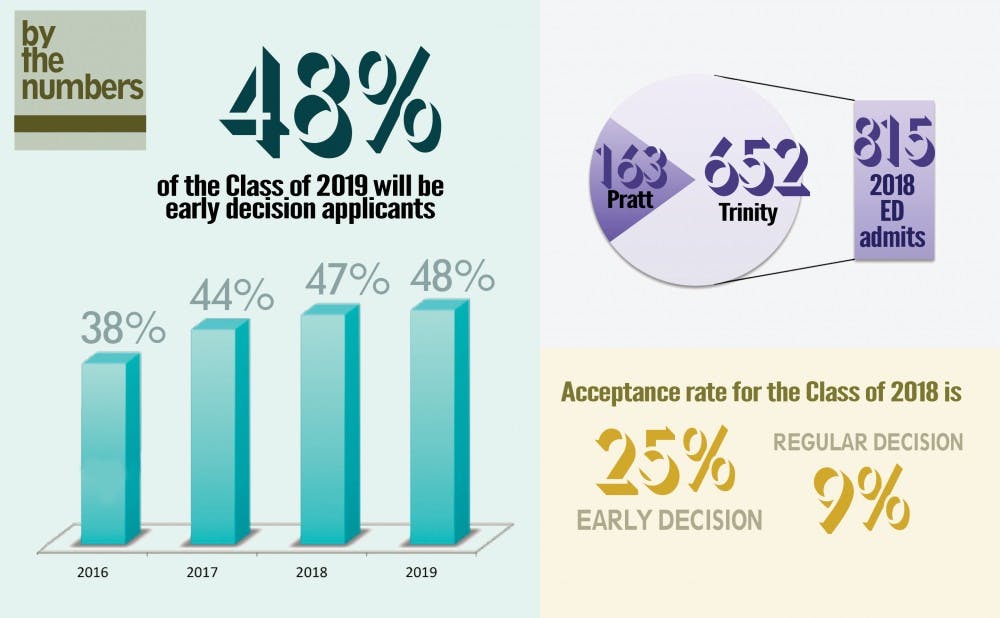Although some peer schools have moved away from binding early decision programs in recent years, Duke stands by its policies.
Critics of early decision have pointed out that binding early decision policies—which require students to commit to the school once they are admitted—have a number of important drawbacks in comparison to non-binding policies. As the University admits an increasing proportion of its incoming classes early, with a record high 48 percent this year, these conversations have taken on a new relevance. Early decision prevents applicants of lower socioeconomic backgrounds from comparing the financial aid packages they receive from their early school with those of other colleges, some critics say.
But Alison Rabil, assistant vice provost and director of financial aid, said this issue is not a problem at Duke.
"Our policies are designed to make it possible for every student who's accepted to Duke to come to Duke," Rabil wrote in an email Jan. 16.
Early decision applicants do tend to come from slightly more affluent socioeconomic backgrounds, but the overall class of admitted students remains relatively diverse in terms of socioeconomic status, Rabil said.
About 50 percent of undergraduates receive some sort of financial aid.
“Our early decision pool has about the same percentage of financial applicants as our regular decision pool," Rabil wrote. "They tend to be a less ‘needy’ pool in general by a little bit…. But we have students in our early decision pool who receive full scholarships next to those who only qualify for loans and work study.”
Some applicants from lower-income families, however, have cited financial strain as a reason for not applying early.
“I didn’t apply early even though I was planning on doing early apps in the first months of the school year,” said Fernando Rojas, a high school senior and Duke regular decision applicant. “I didn’t want to put my parents through a difficult situation if I was accepted but couldn’t afford the school.”
Some peer institutions have adopted non-binding early action programs, as opposed to binding early decision ones, to alleviate this issue. Both Harvard and Princeton Universities introduced single-choice early action programs in 2011, joining Yale and Stanford Universities.
Marlyn McGrath, director of admissions for Harvard College, noted that early decision may not give applicants sufficient time to consider all their options.
Harvard’s single-choice early action policy strikes the perfect balance between early and regular decision, McGrath said. Some applicants who apply to Harvard in October may realize that they prefer to attend another university in March, she added.
“It allows us in turn to focus our committee’s attention on candidates who have—by choosing to apply early to one place—made a preliminary choice,” she said. “On the other hand we have never offered a binding early program, because we and our faculty believe that every student should be free to make the final college choice until the end of senior year.”
Bev Taylor, founder of the The Ivy Coach, a New York-based college consulting firm, said that opposition to early decision is often due to ignorance of the resources available to applicants. Financial aid calculators exist at nearly every top university, and students can check their financial aid packages before they even apply, she said.
Financial aid packages for students admitted through both early and regular decision are calculated the same way at Duke, Rabil said.
“We don’t change how we calculate the award just because you’ve made a commitment to us for ED," she wrote.
Early decision offers additional benefits, Taylor added. The program provides closure to both colleges and students—a university knows that a part of its class is filled, and prospective students can stop stressing about the college search.
“The beauty of early decision is that these colleges know that if the student is applying, they’re coming," Taylor said.
Taylor noted that applicants may also benefit from higher early decision acceptance rates. At 25 percent, the early decision acceptance rate for the Duke Class of 2018 is higher than its regular decision acceptance rate of 9 percent in the same year. A similar trend is visible at peer universities, both those with early decision and those with early action.
Get The Chronicle straight to your inbox
Signup for our weekly newsletter. Cancel at any time.

